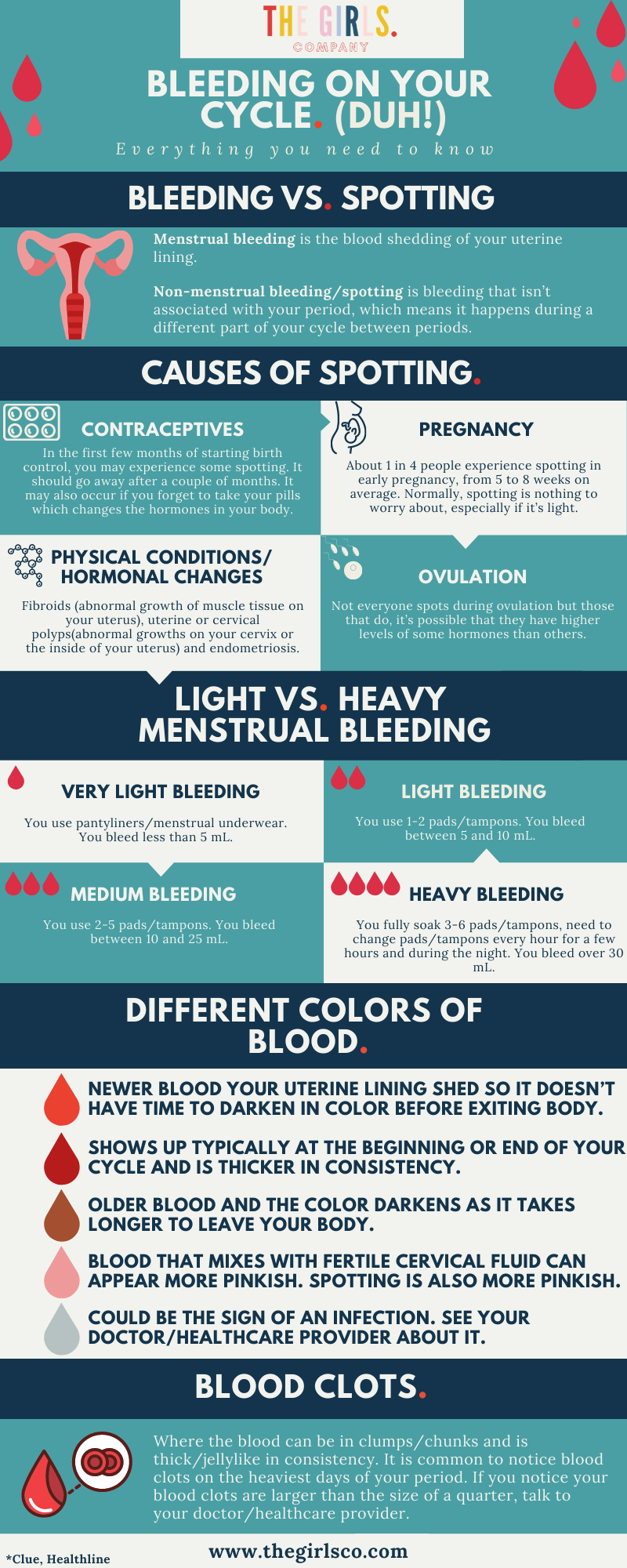Yes we do bleed on our period shocker. But there is so much more to bleeding during our cycle. Here’s everything you need to know about menstrual bleeding, spotting, bleeding heaviness, blood clots, and different colors of menstrual blood.
Let's do it.
What is the difference between menstrual bleeding and non-menstrual bleeding/spotting?
Menstrual bleeding is the blood shedding of your uterine lining.
Non-menstrual bleeding/spotting is bleeding that isn’t associated with your period, which means it happens during a different part of your cycle between periods. With spotting, you may not need to use sanitary protection since it’s a very light amount of bleeding.
Why am I spotting between periods?
Spotting can come from your uterus, cervix or vagina. It is different from your period. Heavy spotting typically comes from your uterus while lighter bleeding typically comes from your cervix or vagina. There could be a few reasons for spotting between periods.
Cause 1: One cause of spotting could be using contraceptives. In the first few months of starting birth control, you may experience some spotting. It should go away after a couple of months. If your spotting continues for longer, consider stopping birth control or switching contraceptives. Spotting may also occur if you forget to take your pills which changes the hormones in your body. If you use other forms of contraceptives different from birth control, such as an IUD, spotting can also be unpredictable. If you ever have any concerns about your spotting, speak to your doctor/health care provider.
Cause 2: Another cause of spotting could be pregnancy. About 1 in 4 people experience spotting in early pregnancy, from 5 to 8 weeks on average. Normally, spotting is nothing to worry about, especially if it’s light. However, if the bleeding is heavier, speak to your doctor/health care provider just to check.
Cause 3: Spotting could also be caused by physical conditions or hormonal changes. Fibroids (abnormal growth of muscle tissue on your uterus), uterine or cervical polyps(abnormal growths on your cervix or the inside of your uterus) and endometriosis.
Cause 4: Spotting can also occur during ovulation. Not everyone does but those that do, it’s possible that they have higher levels of some hormones than others.
What’s “normal bleeding”? (light vs heavy menstrual bleeding)
On average, a normal amount of bleeding is between 5 mL to 80 mL which can also equal up to 6 tablespoons. If you are bleeding more than 80 mL, that is considered heavy bleeding.
The way you bleed and your menstrual cycle is unique to your body and a result of your health. You have to find and understand what’s considered “normal” for you.
There are a number of factors that can affect your hormones which affects how much you bleed every period. This includes stress, birth control, exercise, and diet.
If you are heavy bleeder, over 80 mL or so heavy you soak through pad/tampons every two hours, you should discuss this with your doctor/healthcare provider.
Very Light Bleeding: You use pantyliners/menstrual underwear. You bleed less than 5 mL.
Light Bleeding: You use 1-2 pads/tampons. You bleed between 5 and 10 mL.
Medium Bleeding: You use 2-5 pads/tampons. You bleed between 10 and 25 mL.
Heavy Bleeding: You fully soak 3-6 pads/tampons, need to change pads/tampons every hour for a few hours and during the night. You bleed over 30 mL.
What do the different colors of period blood mean?
Bright red: This period color is newer blood your uterine lining shed so it doesn’t have time to darken in color before exiting your body.
Dark red: This period color shows up typically at the beginning or end of your cycle and is thicker in consistency.
Brown/dark brown: This period color is darker because it is older blood and the color darkens as it takes longer to leave your body.
Pink: Spotting can be more pinkish and can happen outside your menstrual cycle during ovulation. Blood that mixes with fertile cervical fluid can appear more pinkish.
Gray: If you see grayish blood, this could be the sign of an infection. See your doctor/healthcare provider about it.
What are blood clots?
Menstrual blood clots can be a part of your menstrual cycle where the blood can be in clumps/chunks and is thick/jellylike in consistency. It is common to notice blood clots on the heaviest days of your period. If you notice your blood clots are larger than the size of a quarter, talk to your doctor/healthcare provider.
Sources: Clue, Healthline
*Please talk to your doctor/healthcare provider whenever needed. Don't be afraid to ask for help. It's always better to ask and be aware of what's going on in your body.
Honestly, we are all so strong and incredible.


